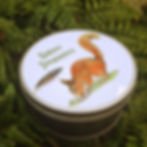Oak Gall Wasps...and other galls
- Abbey Scott
- May 19, 2022
- 4 min read
Updated: Jan 10, 2023
Oak galls are abnormal growths consisting of modified plant tissue. They're caused by the developing larvae of various species of gall wasp.
Galls are very common on Oaks and there are many types. Here are a few of the more common ones you may find.

Cherry Galls are found on the underside of Oak leaves. Inside is a single larvae of the agamic/asexual generation (females that reproduce without mating) of the gall wasp, Cynips quercusfolii. The eggs are laid on the newly emerged Oak leaves in spring.

Over the summer, they grow to around 2cm diameter and get a cherry pink red colour before turning brown in autumn.

They'll remain on the leaves when they fall, then the wasps will emerge from the leaf litter in winter. They then lay the eggs of the sexual generation on the Oak bark. These emerge in spring, mate and lay their eggs on the underside of Oak leaves causing new cherry galls.

Marble Galls are found on the Oak twigs. The gall wasp, Andricus kollari, lay their eggs in the leaf bud in spring, causing the gall to develop around the wasp larva. This is the asexual generation. The female wasp emerges is late summer or early autumn leaving a clear emergence hole. The vacated gall usuals remains on the twig through winter. The female then goes off in search of a Turkey Oak on which to lay the eggs of the sexual generation, which will emerge the following spring.

This is a non-native species that was deliberately introduced in around 1840 as the galls were prized for making iron gall ink. The Turkey Oak, on which it relies to complete it's life cycle, had been introduced in 1735.
Oak Apple Galls are caused by the gall wasp, Biorhiza pallida, which lay their eggs on Oak leaf buds. Unlike most wasp galls, this will contain many larvae, all of the same sex. Like the Cherry Gall Wasp and many other gall wasps, they have two generations, one sexual and one agamic. This gall is caused by the sexual generation and the gall is a deformed leaf. The agamic generation is found on the roots. Adults usually emerge from Oak Apple Galls in June or July.

Knopper Galls are caused by the wasp Andricus quercuscalicis which lays it's eggs in the acorn bud. They also have two generations to complete their lifecycle and it's the all female parthenogenetic generation that causes the Knopper Galls on Pedunculate Oak (Quercus robur) and Sessile oak (Quercus petraea). It will remain in the gall ones it has fallen and emerge the following spring. It will then search for a Turkey Oak (Quercus cerris) on which to deposit it's eggs (on the catkins). These will then develop into the sexual generation that will mate then lay their eggs in developing acorn buds on early summer, resulting in a new generation of Knopper Galls.
The Knopper Gall Wasp is dependent on the non-native Turkey Oak and the Pedunculate or Sessile Oak to complete it's lifecycle. It only arrived in the UK in 1960, but quickly spread due to the presence of Turkey oak which were introduced in the mid 18th century.

Silk Button Galls are one of the two types of gall caused by the gall wasp Neuroterus numismalis. The Silk Button Gall holds the asexual generation of the wasp which spends the winter in the gall on the leaf on the ground, emerging in February to April. The next generation, which is sexual, causes Blister Galls.

Galls are not only found on Oak, and not only caused by gall wasps; they're also caused by other insects, mites, fungi, bacteria and viruses.
Alder Gall Mites (Eriophyes laevis) produce galls on Alder leaves. In autumn the fully grown mites leave the galls through an opening in the underside of the leaf then spend the winter in an alder cone or in the bark of the tree. When the leaves appear in spring, they lay their eggs on the leaves and new galls develop.

Hairy Beech Galls contain the larvae of a midge, Hartigiola annulipes. They drop to the ground in Autumn and the midge will emerge in spring.

Willow Gall Sawfly (Pontania pedunculi) causes hairy pea shaped galls on Goat Willow, Grey Willow and Eared Willow. They start green and turn pink as they develop. After emerging from the gall on the fallen leaf in autumn, the larvae will form a cocoon where they will remain over winter before emerging as adult sawflies in spring.

Historically, various galls have been used to make ink (iron gall ink). We've made some with Knopper galls. This is what we did:
Soaked some wire wool in vinegar for a few days;
Covered the vacated Knopper galls in water and boiler for about 20 mins (you can check they're vacated by the time of year and presence of small exit holes);
Strained the two liquids separately through muslin;
Mixed a little of each together (but also kept some of the pure knopper water). The mixed ink will be black and the pure knopper water will be brown. Warning: the black does stain.

I painted the Tawny Owl in The Tree That Held The Moon using Knopper Gall ink.


















